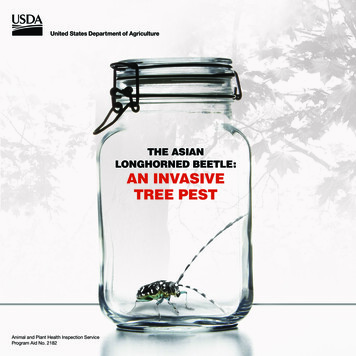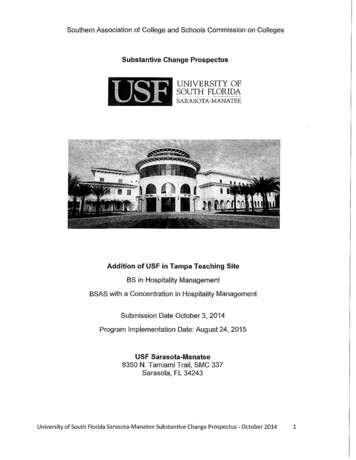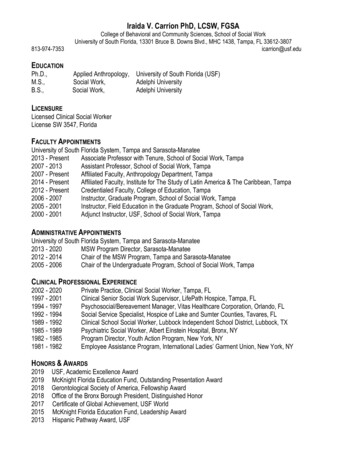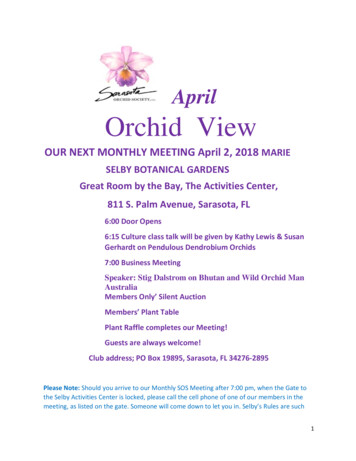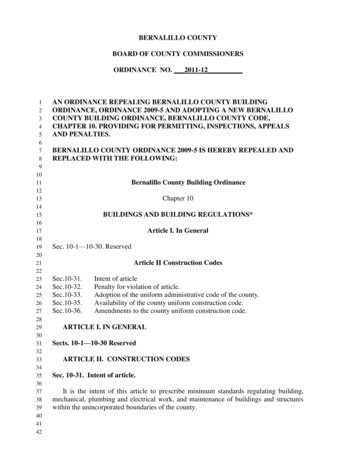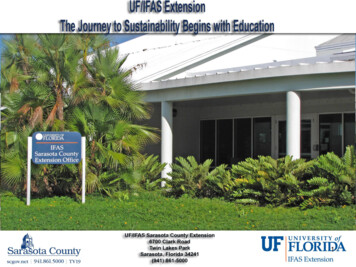
Transcription
1
UF/IFAS EXTENSION SARASOTA COUNTY A partnership between Sarasota County, theUniversity of Florida, and the USDA. Our Mission is to translate research into communityinitiatives, classes, and volunteer opportunities related tofive core areas: Agriculture;Lawn and Garden;Natural Resources and Sustainability;Nutrition and Healthy Living; andYouth Development -- 4-H
What is Sarasota Extension?
Meet The Plant“Cucurbitaceae”(Natural & Cultural Historyof Cucurbits or Gourd Family)Robert Kluson, Ph.D.4Ag/NR Ext. Agent, UF/IFAS Extension Sarasota Co.
OUTLINE Overview of “Meet The Plant” Series Introduction to Cucubitaceae Family What’s In A Name? Natural History Center of origin Botany Phytochemistry Cultural History Food and other uses5
Approach of Talks on“Meet The Plant” Today my talk at this workshop is part of aseries of presentations intended to expandthe awareness and familiarity of thegeneral public with different worldwide andFlorida crops. It’s not focused on crop production. Provide background information from thesciences of the natural and cultural historyof crops from different plant families. 6
“Meet The Plant” Series Titles(2018) Brassicaceae CannabaceaeJan 16thJan 23rd LeguminaceaeFeb 26th SolanaceaeMar 26th CucurbitaceaeMay 3rd7
What’s In A Name? Cucurbitaceae the Cucurbitaceae family is also known as thecucurbit or gourd family. a moderately size plant family consisting ofabout 965 species in around 95 genera - the mostimportant for crops of which are: Cucurbita – squash, pumpkin, zucchini, somegourdsLagenaria – calabash, and others that are inedibleCitrullus – watermelon (C. lanatus, C. colocynthis)and othersCucumis – cucumber (C. sativus), various melonsLuffa – the common name is also luffa, sometimesspelled loofah8
What’s In A Name? Cucurbitaceae Etymology: The name Cucurbitaceae derives from the typegenus Cucurbita, "the squash crops". The genus name comes from c. 1300, from AngloFrench “gourde”, Old French “coorde”, ultimately fromthe classical Latin word “cucurbita” (gourd). It is ofuncertain origin, perhaps related to “cucumis”(cucumber).9
What’s In A Name? Squash Etymology: gourd fruit, 1640s, shortened borrowing fromNarraganset (Algonquian) “askutasquash”, literally "thethings that may be eaten raw," from askut "green, raw,uncooked" asquash "eaten," in which the -ash is a pluralaffix (compare succotash). Zuchinni Etymology: 1915 in English cookery books, 1910 in travel booksabout Italy as an Italian word (defined as "an odd kind oflittle squash, very tender and palatable"), from Italian,plural of “zucchino”, diminutive of “zucca” (gourd, squash)10perhaps from Late Latin “cucutia”.
What’s In A Name? Pumpkin Etymology: 1640s, alteration of “pompone”, “pumpion” (melon,pumpkin) (1540s), from Middle French “pompon”, fromLatin “peponem” (nominative pepo) (melon), from Greek“pepon” (melon) Pumpkin-pie is recorded from 1650s. Pumpkin-head,American English colloquial for "person with hair cut shortall around" is recorded from 1781. Vulgar AmericanEnglish alternative spelling punkin attested by 1806.11
What’s In A Name? Cucumber Etymology: late 14c., from Old French “cocombre” (13c., ModernFrench “concombre”), from Latin “cucumerem” (nominativecucumis), perhaps from a pre-Italic Mediterraneanlanguage. The Latin word also is the source of Italian“cocomero”, Spanish “cohombro”, Portuguese “cogombro”.Replaced Old English “eorþæppla” (plural), literally "earthapples." “Cowcumber” was common form 17c.-18c., and thatpronunciation lingered into 19c. Planted as a gardenvegetable by 1609 by Jamestown colonists. Phrase ‘cool asa cucumber’ (c. 1732) embodies ancient folk knowledgeconfirmed by science in 1970: inside of a field cucumber12ona warm day is 20 degrees cooler than the air temperature.
What’s In A Name? Melon Etymology: late 14c., from Old French “melon” (13c.), from MedievalLatin “melonem” (nominative melo), from Latin“melopeponem”, a kind of pumpkin, from Greek “melopepon”(gourd-apple - name for several kinds of gourds bearingsweet fruit), from melon "apple" pepon, a kind of gourd in Greek, melon was used in a generic way for all foreignfruits (compare similar use of apple).13
CucurbitaceaeNatural History14
Natural History and Botany The Cucurbitaceae consist of mesophytic orxerophytic species, mainly found in tropical orsubtropical regions. All species are sensitive to frost. Most of the plants in this family are annual vines,but some are woody lianas, thorny shrubs(Acanthosicyos), or trees (Dendrosicyos). Many species have large,yellow or white flowers with5 petals. The stems arehairy and pentangular.15
Natural History: Botany The plants grow asvines as eitherprostrate along theground or climbusing tendrils. Tendrils are usuallyfour arched filamentscoiling with anadhesive texture. Tendrils are presentat 90 to the base ofleaf petioles atnodes.TendrilTendrils16
Natural History: Botany Leaf shapes can range from simple to palmatelycompound. Those leaves that develop later are more deeplylobed and extra-floral nectaries are often found.17
Natural History: Botany Roots tap root type capable ofachieving adeep depth.Cucumber18
Natural History: Botany Flowers While they are extremely diverse infruit and vine characteristics, theirfloral structures are in manyrespects very similar. In general, the family ischaracterized by the flowering habitknown as monoecious. A monoecious species or variety isone that bears its pistillate or femaleorgans of reproduction and itsstaminate or male organs inseparate flowers, both kinds offlowers occurring on the same plant.19
Natural History: Botany Flowers (cont.) Cucumber, squash, and pumpkin are normally strictlymonoecious, but certain varieties of muskmelon andwatermelon show a modification of this condition thatis termed andromonoecious. An andromonoecious plant is one that bears bisexualor complete flowers, instead of strictly pistillate ones,in addition to purely staminate flowers.20
Natural History and Botany Fruits soft, fleshy, indehiscent and a type of berrycalled pepo. sometimes very large in size (Citrullus spp.;Cucurbita spp.).vs21
Natural History: Pollination Cucurbit flowers are short livedflowers that open a few hours aftersunrise and are often closed bymidday or early afternoon. Both malepollen viability and female stigmaticreceptivity are at their highest whenthe flower opens and for the next fewhours. Both pollen viability and stigmatic receptivity decreasesignificantly as the day progresses. It is important for thefemale flower to be pollinated as early in the day aspossible.22
Natural History: Pollination In cucurbits there is one key concept: The quality of the fruit is a function of the number of seeds inthe fruit. The number of seeds produced is a function of thenumber of viable pollen grains deposited on the stigma. Thenumber of pollen grains deposited is a function of thenumber of visits by pollinators as well as by the type of beevisiting the flower. Because both male and female sexual parts are not in thesame flower, pollen must be transferred from the maleflower to the female flower. The pollen is too large andsticky to be transferred by wind and thus requires insecttransfer. Bumble bees tend to deposit more pollen per visitthan squash bees and squash bees tend to deposit morepollen per visit than honey bees. The UV-reflective flower petals direct the pollinators.23
Natural History: PollinationBumble Bee onCucumber FlowersSquashBeeGroundNest24
Natural History: Pollination25
Natural History: Pollination26
Natural History: Chemical Ecology Biologically active phytochemicals arefound in Cucurbitaceae plants. They are produced by plant “secondary”metabolism that produces compounds suchas caratenoids, alkaloids, flavonoids,anthocyanidins, terpenes and phenolics. Secondary phytochemicals are organiccompounds that are not directly involved inthe normal growth, development, orreproduction of an organism. Secondarymetabolites often play an important role inplant chemical-based ecological interactionswith their biotic and non-biotic environment.27
Natural History: Chemical Ecology Secondary PhytochemicalResearch:Plant chemical defense example Plant phytochemical research demonstrates multipleecological processes for these metabolites.28
Natural History: Chemical Ecology Flowers Watermelon Research the phytohormone gas ethyleneregulates differentially two sexrelated developmental processes:a) sexual expression, i.e. theearliness andb) the number of female flowersper plant, and the development ofindividual floral buds. the female flower requires much more ethylene than the maleone to develop, and that bisexual flowers result from adecrease in ethylene production in the female floral bud. the occurrence of bisexual flowers was found to be associatedwith elevated temperatures in the greenhouse, concomitantly29with a reduction of ethylene production in the shoot apex.
Natural History: Chemical Ecology Allelopathy Allelopathy is “the chemical warfare between plants,” Itoccurs when plants produce natural chemicals, known asallelochemicals, that inhibit the growth of competingspecies. Consider the ancient “Three Sisters”cropping system three food plants traditionally growntogether by native Americans, and thereasons why the crop combinationworks: the corn acts as a pole for the climbing beans; the beans fixnitrogen, thereby providing an important plant nutrient; andthe squash inhibits weeds.30
31Mutualistic interactions are the basis of this cropping systems
Natural History: Chemical Ecology Allelopathy (cont.) Research has demonstrated the squash effect due to acombination of shading by the broad leaves and release ofallelochemicals against the weeds. For example, reduced germination and growth of a widediversity of weeds has been demonstrated from extracts ofcucurbit roots and shoots, and foliage leachates andvolatiles. The effect increased with concentration. Better yet, these chemicals often inhibit weeds more thanthey impact crop plants.32
Natural History: Chemical Ecology Cucurbitacins Cucurbitaceae is phytochemicallycharacterized by the presence ofmore that 20 extremely bitter andtoxic oxygenated tetracyclictriterpenoids, the cucurbitacins(figure 1). Cucurbitacins are typically found in the roots, stems,cotyledons, leaves and fruits of cucurbits. Theconcentrations increases with age. Research on cucurbitacins has shown them to be a tastedeterrent in plants foraged by some animals and in someedible plants preferred by humans, like cucumbers.33
Natural History As is the situation with all defense systems of plants andanimals, a few specialized pathogens have co-evolved withplants and have overcome the chemical defense barrier. Furthermore, they are often attracted by a given plantphytochemical toxin. For example, The Aulacophorites and Diabroticites insectgenera include some of the world's most destructive insectspecialist for cucurbits.Spotted cucumber beetle (Diabroticaundecimpunctata howardi)Banded pumpkin beetle(Aulacophora hilaris)34
CucurbitaceaeCultural History35
Cultural History The Cucurbitaceae are one of the mostimportant plant taxon economically and themost valuable in terms of vegetable crops,ranking among the highest of plant familiesfor number and percentage of species usedas human food. The plants in this family are grown aroundthe tropics and in temperate areas, wherethose with edible fruits were among theearliest cultivated plants in both the Old andNew Worlds.36
Major Cucurbitaceae Crops Cucurbita pepo – summer squash, acorns,Jack O’ lanterns, ‘Delicatas’, patty pans Cucurbita pepo subsp. ovifera-yellow flw.gourds Cucurbita maxima – Hubbards, Buttercups Cucurbita moschata – Butternuts Cucurbita argyrosperma – most cushaws Cucumis sativus – cucumber Cucumis melo – melon Citrullus lanatus – watermelon Lagenaria siceraria – white flowered gourds
Cultural History38
Cultural History Fruits are the most commonly eaten part of the plant,but seeds, flowers, tendrils, very young shoots, androots are also used for food. Cucurbits are utilized for other practical purposes aswell, such as to store food (gourd) or to be used as asponge (loofah).Tendrils39
Cucurbitaceae Crop Diversity It is estimated that humans have been growing andeating Cucurbitaceae food crops for thousands ofyears. Historical dates of example crops include:–––––––Squash/Pumpkin (Cucurbita. pepo):Winter Squash (C. maxima):Butternut Squash (C. moschata):Cushaw (C. argyrosperma)Cucumber (Cucumis sativus):Melon (Cucumis melo)Watermelon (C. lanatus)10,000 BCE2,500 BCE5,000 BCE7,000 BCE3,000 BCE3,000 BCE2,000 BCE Although the exact number might be unknown, one canestimate that there are hundreds of varieties ofCucurbitaceae crops, including many local varieties that40are not exported or grown worldwide.
Cucurbitaceae Crop Diversity How Did Cucurbitaceae Crops & CultivarsOriginate?– Crop domestication human-induced plant adaptation– Centers of Origin have wild relatives of the crop.– Hybridization and polyploid formation are importantdriving forces in crop evolution– In each Center of Origin numerous crops weredomesticated– Genetic diversity can be measured at the molecularlevel141
Cucurbitaceae Crop Diversity:Centers of Origin **********1**42
Squash and Pumpkin(Cucurbita pepo) The varieties of squash andpumpkin originated invarious places throughoutthe Americas. C. pepo is the earliest formof squash discovered andone of the oldest, if not theoldest, domesticatedspecies.43
Squash (Cucurbita pepo) Squash has its origins in theNew World, specifically centralMexico, Peru and the Easternside of the United States. Native Americans cultivatedsquash heavily beforeEuropean contact also; fromtrade and mixing, squashmade its way to the Old Worldafter 1492 with Columbus‘exploration. Includes all “summer squash”from patty pans, zucchini,yellow squash/crooknecks.44
Pumpkin (Cucurbita pepo) Pumpkins were brought to the Old World soon after thecommencement of the first European explorations of the NewWorld and are mentioned in early European works starting in1536. Pumpkins are cultivars of a squash plant that is round, withsmooth, slightly ribbed skin, and deep yellow to orangecoloration. The thick shell contains the seeds and pulp. Some exceptionally large cultivars of squash with similarappearance have also been derived from Cucurbita maxima. Specific cultivars of winter squash derived from otherspecies, including C. argyrosperma, and C. moschata, arealso sometimes called "pumpkin". In New Zealand and Australian English, the term pumpkingenerally refers to the broader category called winter squashelsewhere.45
Pumpkin (Cucurbita pepo)Variety Examples46
Winter Squash (Cucurbita maxima) Originally from the Andean highlands. Cucurbitamaxima originated and was domesticated inSouth America. It has a less wide spread history,primarily found on the coast of Peru, with otherremnants found in Argentina, northern Chile,and Paraguay. Adapted to moderate daytime temperature andcool night time temperatures Includes all Hubbard and Buttercup types All Japanese Kabocha/Hokkaido types
Winter Squash (Cucurbita maxima) Can produce the largest fruit on earth Includes the large “show” pumpkins like ‘AtlanticGiant’, ‘Hungarian Mammouth’, which all have amilky orange color
WinterSquashs49
QUIZ50
Quiz Answers First, it has nothing to do with when they are plantedand grown! Second, here’s how summer and winter squash arethe same: All varieties of squash can be sorted into two main types:summer and winter. All squashes are warm weather plants that will not toleratefreezing temperatures. Squashes start very well when directly seeded into thegarden. Transplanted squash can be stunted and produce very littleif the roots are disturbed at transplanting. All squashes make male and female flowers.51 All squashes have edible flowers!
Quiz Answers (cont.) Finally, here’s how summer and winter squash aredifferent: Summer squashes so called because they produce fruit that is ready forharvest and consumption during the warm summermonths. grow as large bushes and need at least 3 feetbetween plants. will produce more fruit than a winter squash and willstart producing earlier in the season (50-70 days) tastiest when harvested young while the skin is stilltender and the seeds inside are still immature. cultivars of C. pepo52
Quiz Answers (cont.) Finally, here’s how summer and winter squash aredifferent (cont.): Winter squashs so called because the fruit of these plants are often not readyfor harvest until the end of the summer and many types willstore very well so they can be eaten in the winter. generally are large vining plants that may grow to 10 feet longor more. Leave at least 6 feet between winter squash plants. plants only make 1 to 3 fruits per plant, and mature much later(120 days) fruit should be left on the plant until fully mature: when the skinis hard and the plant has died. fruit, except acorn squash, also need to be cured prior toeating them. The curing process allows the fruit to be storedlonger and become sweeter.53 cultivars of C. maxima
Cushaw Squash(Cucurbita argyrosperma) Species originated in thelowlands of CentralAmerica and Mexico Adapted to high daytimetemperature and warmnighttime temperatures Fruit are very late maturing! C. argyrosperma (formerlyC. mixta) include many ofthe “cushaws” (USA) andcalabaza (Hispanic).
Butternut Pumpkin or Squash(Cucurbita moschata) Species typically cited as Mesoamerican in originwith unknown exact locations. It was thought that C.moschata was of Asiatic origin. However, it is nowevident that it was domesticated in Latin America. Adapted to high daytime temperature and warmnighttime temperatures Fruit are very late maturing! Also includes many “cheese pumpkins”
The genus Cucumis Cucumis sativus – “true cucumber” Cucumis melo – “melons” (following types)–––––––Reticulatus group–muskmelon, nutmeg m.Inodorus group – honeydew, casabaFlexuosus group – Armenian cucumberDudaim group – Queen Anne’s pocket m.Chito group – vine peach, melon appleConomon group – Freeman cucumberCantalupensis group – true cantaloupes
Cucumber (Cucumis sativa) Domesticated in India & other parts of WesternAsia. Wild plant relatives of the cucumber canbe found in the foothills of the HimalayaMountains, China and Near/Middle East. From India, the cucumber was carried to Greece and Italy,where it played a pivotal role in the Roman Empire. Spread tothe rest of Europe by the Romans, the cucumber was laterdispersed to the New World through colonialism andindigenous trade. In the New World the crop spread up to Florida and then out tothe Great Plains through Native American tribes. NativeAmerican tribes such as the Iroquois adopted the cucumbersinto their gardens soon after their introduction to the continent. Domestic versions of the cucumber were first found in NorthAmerica in the 19th century and include: Arlington White 57Spine, Boston Pickling and Chicago Pickling.
Cucumber Variety ExamplesCucumbers of IndiaArmenianCucumber(C. melo)58
Melon (Cucumis melo) Based on genetic studies, crossing attempts with otherCucumis species, and world distribution of melonvarieties, the origin of melon appears to be Africa. The domestication process of melon started in Egyptover 3,000 years ago. From this area, melon dispersed throughout the MiddleEast and Asia, where a secondary domestication anddiversification development may have occurred. Among the major cucurbit vegetables, C. melo has oneof the highest polymorphic fruit types and botanicalvarieties. This is a consequence of genetic diversity inthis species.59
Watermelon (Citrullus lanatus) The watermelon is a cucurbit that originated in northeastAfrica, where it is found growing wild. Evidence of the first cultivation of C. lanatus in the NileValley has been found (2,000 BCE), and seeds havebeen found at Twelfth Dynasty sites and in the tomb ofPharaoh Tutankhamun Watermelon cultivation then spread to India (700 CE),China and Spain (1,000 CE) and Europe (1,600 CE) European colonists and slaves from Africa introduced thewatermelon to the New World. Spanish settlers weregrowing it in Florida in 1576. The more than 1200 cultivars of watermelon range inweight from less than 1 kg to more than 90 kilograms(200 lb); the flesh can be red, pink, orange, yellow or 60white.
Seedless Watermelon(Citrullus lanatus) Seedless watermelons are sterile hybrids thatdevelop fruits, but no seeds. The seeds for growing them areproduced by crossing a normalwatermelon with one that hasbeen changed genetically bytreatment with a chemicalcalled colchicine. The seeds from this cross will produce plants that,when pollinated with pollen from normal plants,produce seedless melons because they are infertilepolyploids (3N instead of 2N).61
62
Cultural History Cucurbitaceae cropbreeding history includedboth selection for & removalof natural phytochemicalsfound in wild types incenters of origin. For example, the medicinaluse of phytochemicals fromdifferent plant families has along history with humanpopulations, a.k.a. “food asmedicine” Picture shows examples of crops bred from wild plantswith medicinal phytochemicals.63
Cucurbitaceae Crops Medicinal Foods The current trend to a healthier food and thecontinuing quest for new drugs explain theattention given to cucurbit crops as a source ofbioactive compounds that can serve ascandidates for medicinal foods and/orpharmacological drugs. For example, some cucurbits such as Cucurbitaandreana are exploited as medicines, which havechemical compounds (cucurbitacins) withanticancer and anti-inflammatory activities.
Cucurbitaceae Crops Medicinal Foods (cont.) In China, fruits and roots of Cucurbita melo are takenas an emetic, the leaves and seeds used to treathematoma, and the stems to reduce hypertension. The pulp of Citrullus colocynthesis is used as apurgative and for intestinal disorders, such as dropsy. Research has generally shown different cucurbitsecondary metabolites, such as triterpernoids,alkaloids, and others, which are responsible forbiological activity as antidiabetic, antitumoral,antiparasitic, antibacterial, and anti-inflammatorycompounds. Therefore some substances areconsidered useful scaffolds for developing new drugs.
66
Cucurbitaceae Crops Misc Uses The hard woody pericarp of Lagenaria ualgaris isused in the manufacture of excellent flasks,primitive vessels, utensils, snake blow pipes, drumfor tambura, soraja, and in the construction of othermusical instruments. The vines of this family are used for ornamentalpurposes.
Cucurbitaceae Crops Grafting Grafting of cucurbits is now possible to provideprotection from root pathogens for increased cropintroductions and production.Major grafting methods in cucurbits (and solanaceous)vegetables: (A and B) hole insertion grafting; (C)tongue approach grafting; (D, E and J) splice grafting;(F, G) cleft grafting; (H and I) pin grafting.
Now a Gallery ofCucurbitaceae Art The CucurbitImages (1515–1518)of the VillaFarnesina, Rome69
The Cucurbit Images (1515–1518)of the Villa Farnesina, RomeImages ofWatermelons inthe Festoons70
The Cucurbit Images (1515–1518)of the Villa Farnesina, RomeImages ofMelons in theFestoons71
The Cucurbit Images (1515–1518)of the Villa Farnesina, RomeImages ofCucumbers inthe Festoons72
The Cucurbit Images (1515–1518)of the Villa Farnesina, RomeImages ofGourds in theFestoons73
The Cucurbit Images (1515–1518)of the Villa Farnesina, RomeImages ofPumpkins in theFestoons74
Still Leben mit Kurbissenca. 1650
Archimboldo Autumn 1573CucumberSquash76
Thank You !77
References and Resources Bisognin, D.A. 2002. Origin and Evolution of Cultivated Cucurbits.Ciencia Rural vol.32 (4) – seehttp://www.scielo.br/scielo.php?script sci arttext&pid S010384782002000400028 Darrigues, A. 2003. Evolution of Crops – volution%20of%20crops%20-%20D.Tay2.pdf Deyo, A. and B. O’Malley. Cucurbitaceae – r Research files/cucurbitaceae.pdf Foord, K. Pollination in the Vegetable Garden – Cucurbits. Univ. of MNExtension – see /05/pollination-in-vegetable-garden.html Gardening Channel. What’s The Difference Between Summer andWinter Squashs? – see ce-between-summer-and-winter-squash-anyway/78
References and Resources Janick, J. and H. Paris. 2006. The Cucurbit Images (1515–1518) of theVilla Farnesina, Rome. Annals of Botany, Volume 97 (2):165–176 –see 54 Khoury, C., et.al., Origins of food crops connect countries worldwide nt/royprsb/283/1832/20160792.full.pdf Kruse-Peeples, M. 2017. Squash Pollination – squashpollination-2 Kuepper, G. and M. Dodson. 2016. Companion Planting & BotanicalPesticides: Concepts & Resources – see php?pub 72 Manzano, S., et. al., 2014. Involvement of ethylene in sex expressionand female flower development in watermelon (Citrullus lanatus). PlantPhysiology and Biochemistry Volume 85 (Dec): 96-104 – ii/S098194281400337479
References and Resources Medcalf, R.L. and R. Lampman. 1989. The chemical ecology ofDiabroticites and Cucurbitaceae. Cellular and Molecular Life Sciences Vol45(3):240-247 – 556 The chemical ecology of Diabroticites and Cucurbitaceae Mother Earth News. A Crop By Crop Guide – 3KnoGP3v7 Navazio, J. Cucurbitaceae – html# Nunez-Palenias, H.G., et. al., 2008. Melon Fruits: Genetic Diversity,Physiology, and Biotechnology Features. Critical Reviews in Biotechnology,28:13–55 – 88550801891111 Online Etymology Dictionary. – see https://www.etymonline.com/ Quasm, J.R. and R.R. Issa. 2005. Allelopathic effects of Squash (80
References and Resources Cucurbita pepo L. cv. Scarlette) on certain common weed species inJordan – 2/1/2630 qasemj.htm Richardson, J. Plant Squash To Keep Weeds Down – -squash-keep-weedsdown Saade, R.L. and S.M. Hernandez. Cucurbits. Purdue University – html Shah, S.S.A., et. al., 2014. Natural Products; PharmacologicalImportance of Family Cucurbitaceae: A Brief Review – 899 Natural Products Pharmacological Importance of Family Cucurbitaceae A Brief Review Stephens, J.M. 2015. Watermelon, Seedless — Citrullus lanatus(Thunb.) Mansf. – see http://edis.ifas.ufl.edu/mv152 Texas A&M University. Cucurbitaceae – Cucurbit or Gourd Family rt/Dicots/Dillen/Cuc/Cuc.html
References and Resources Wikipedia. Cucrbitaceae – seehttps://en.wikipedia.org/wiki/Cucurbitaceae Whitaker, T.W., and I.C. Jagger. 1937. Breeding and Improvement ofCucurbits – /PDF Yashasvi, B. Cucurbitaceae: Characters, Distribution and Types – d-types/4819882
Video Resources Univ of MI Squash Bee Project. Squash Bee Identification and Squash BeeNatural History Video – see http://vegetable.ent.msu.edu/squash-bee-project/ Vimeo Videoa) Pollination 2-2 — Cucumber, Squash, Melon –see https://vimeo.com/147809017 Youtube Videoa) Cucurbitaceae – see https://www.youtube.com/watch?v X0PNbQvVoD0b) How to Graft Cucurbits – seehttps://www.youtube.com/watch?v XVVM-bUj574c) Seedless Watermelon — You'll Never Guess How It's Grown – seehttps://www.youtube.com/watch?v ohN0y03yMcod) Squared Watermelons – seehttps://www.youtube.com/watch?v 2JNSpMhJLvg 83
1915 in English cookery books, 1910 in travel books about Italy as an Italian word (defined as "an odd kind of little squash, very tender and palatable"), from Italian, . The Latin word also is the source of Italian "cocomero", Spanish "cohombro", Portuguese "cogombro". Replaced Old English "eorþæppla" (plural), literally .

